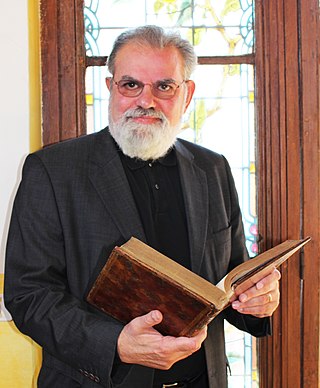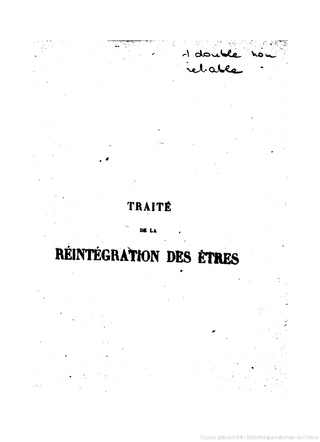
Martinism is a form of Christian mysticism and esoteric Christianity concerned with the fall of the first man, his materialistic state of being, deprived of his own, divine source, and the process of his eventual return, called 'Reintegration'.

The Ancient and Primitive Rite of Memphis-Misraïm is a masonic rite founded in Naples, Italy in September 1881 by the merger of two older rites; the Rite of Misraïm and the Rite of Memphis, both founded in the 18th century. The system is sometimes known as "Egyptian Freemasonry" due to the invocation of hermetic-derived esoteric symbolism referencing Ancient Egypt in its system of degrees.

Joseph Paul Oswald Wirth was a Swiss occultist, artist and author. He studied esotericism and symbolism with Stanislas de Guaita and in 1889 he created, under the guidance of de Guaita, a cartomantic Tarot consisting only of the twenty-two Major Arcana. Known as "Les 22 Arcanes du Tarot Kabbalistique", it followed the designs of the Tarot de Marseille closely but introduced several alterations, incorporating extant occult symbolism into the cards. The Wirth/de Guaita deck is significant in the history of the tarot for being the first in a long line of occult, cartomantic, and initiatory decks.

The Rectified Scottish Rite (RER), also known as the Rectified Rite or RSR, is a Christian Masonic rite with a long and complex history. It was founded in 1778 at the Convent of Lyon in France under the leadership of Jean-Baptiste Willermoz, who served as the primary architect and driving force behind its formation. It emerged as a reform and restructuring of the earlier Templar Strict Observance system that had spread in Germany and France in the mid-18th century.
The history of Freemasonry in Belgium reflects the many influences on what is now Belgium from the neighbouring states.
Paul Copin-Albancelli was a French journalist, nationalist and conspiracy author.
The Primitive Scottish Rite is a Masonic Rite. According to Robert Ambelain, an esotericist who "awakened" it in 1985, it was the rite used by the St. John of Scotland Lodge in Marseille, which was introduced to France in Saint-Germain-en-Laye from 1688; these claims are disputed by historians.

Jean-Baptiste Willermoz was a French Freemason and Martinist who played an important role in the establishment of various systems of Masonic high-degrees in his time in both France and Germany.

Pierre Mollier is a French historian and freemason, born in Lyon in 1961. A graduate of Sciences Po, he holds a master's degree in Religious Studies, and is the director of the library, archives, and museum for the Grand Orient de France.
Paul Naudon, was a Doctor of Law and a 20th-century French historian, author of several books on freemasonry.

The Order of Knight-Masons Elect Priests of the Universe or simply Élus Coëns, was a theurgical organisation founded by Martinez de Pasqually. It appeared in France in the second half of the 18th century and is the first branch of Martinist tradition, otherwise known as Martinezism.

The Treatise on the Reintegration of Beings into Their Original Estate, Virtues and Powers both Spiritual and Divine is a book written by Martinès de Pasqually—a theurgist and Christian theosopher of uncertain origin—in 1772–1773.

Jean-Marie Ragon de Bettignies was a Freemason, author and editor.

In Freemasonry, the first three Masonic degrees constitute the fundamental degrees in all Rites they are called Blue Lodge of Craft degree.
The Philosophical Scottish Rite is a Masonic rite that was established in Paris in 1776 by the hermetist Alexandre Boileau, who was a disciple of Antoine-Joseph Pernéty. This rite is known for its unique structure and progression through various degrees.
The Rite des philalèthes(Rite of the Philalethes) comes from, Philalèthes or philalètes, which translates to: friend or seeker of truth, from the Greek Philos, friend and alètheia, truth, is in freemasonry, the name given to the Rite of the Philalethes and its practitioners. This system of philosophical or mystical Freemasonry was founded in 1773 by Marquis Charles-Pierre-Paul Savalette de Langes within the Masonic lodge "Les Amis réunis", of which he was the worshipful master and a founding member. This rite continued until the death of its founder in 1797.
The Adonhiramite Rite is a Masonic system consisting of 13 grades or degrees, created in 1787 by the German occultist Baron von Tschoudy (1727-1769). It was published in Tschoudy's book Recueil précieux de la Maçonnerie Adonhiramique. This rite combines Templar, Rosicrucian and other esoteric influences into a unique Masonic structure.
The Philosophical French Rite is a Masonic rite that emerged within the Grand Orient de France (GODF) in the late 20th century. Developed by the members of the Tolérance lodge in Paris between 1969 and 2002, it aimed to offer a renewed approach to the symbolic and philosophical aspects of Freemasonry.
The Orders of Wisdom is the contemporary designation for the high Masonic degrees of the French Rite. Originally designated as Ordres supérieurs, they were published in 1801 in a compendium entitled Le Régulateur des Chevaliers maçonsor Les Quatre ordres supérieurs, according to the regimen of the Grand Orient. The Orders of Wisdom were codified by the Chamber of Grades and the Grand Chapter General of France between 1783 and 1785 under the impetus of Alexandre Roëttiers de Montaleau, and subsequently integrated into the Grand Orient de France (GODF) on February 17, 1786. The rituals of the Orders of Wisdom continue the degree of "master", extending and deepening a symbolic and initiatory journey that commenced in the "blue lodge." The Orders of Wisdom were originally divided into four initiatory and philosophical orders and a fifth administrative and conservatory order.










